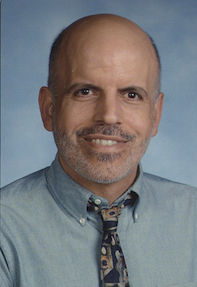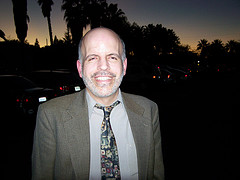Larry Ferlazzo, Impresario
Larry Ferlazzo is the Internet Impresario of Education Resources.
His eponymous Websites of the Day is very possibly the most extensive single-site resource for K12 educators anywhere in cyberspace. Certainly it will be soon, because he adds an awesome amount of content every day. Remarkably, he’s still a conscientious, full-time classroom teacher. And no spring chicken!

Larry’s resource-oriented website is truly vast, with more than 900 “Best of…” articles (regularly updated) among the many thousands he’s posted. He added Twitter to his toolkit a couple of years ago, and Ferlazzo fans are now able to sign up as followers and dip into his daily flow anytime we want. It’s always refreshing. I asked Larry about his blogs, his books, and his teaching life.
UPDATE: Larry’s latest book Self-Driven Learning is reviewed here at MiddleWeb.
1. Tell us about your main web presence – Larry Ferlazzo’s Websites of the Day. When and how did it get started and how has it morphed since you launched it back in 2006? Your scope has really grown over the years. Do you still consider it primarily a site about teaching English Language Learners?
I began my Websites Of The Day blog about five-and-a-half years ago as a way to compile resources to use in the ESL classes I was teaching at our high school. I figured that if my students and I were finding them helpful, then perhaps others would, too. The Web, with its interactivity and ability to provide audio and visual support to text, is an invaluable asset to second language learners.
Though a major focus of the site continues to be providing resources for English Language Learner teachers and students, I have definitely expanded its scope over the years to support me in the multiple subjects I teach. In any given year I can be teaching any grade level of English including newcomers and mainstream students, along with every type of Social Studies course and an International Baccalaureate Theory of Knowledge class. I also use the blog to catalog useful research in teaching and learning that I believe can help me in my own practice. Though its scope has expanded, I still only write about topics that are useful to my students, my colleagues at our school, and to me.
I also write about what I do in my own classroom, and what works and what doesn’t go so well. I try to write about my students often, and share with them what I write. They feel justifiably proud that what they do in our classroom can help students and teachers elsewhere.
And yes, I also use the blog as a “soapbox” for my views on educational policy issues. You can take a person out of the community organizing field (I was one for 19 years before I became a teacher), but you can’t take the community organizer out of the person! Offering my strong views (though I also like to think they can be nuanced) are part of my contribution towards making social change.
2. What useful kinds of information will educators in grades 4-8 find at Websites of the Day?
I think there is little that middle grades educators wouldn’t find useful. And I say that from some experience, since I was a middle school teacher for a year prior to coming to Burbank High School eight years ago.
I have over 900 categorized “The Best…” lists that are constantly revised and updated, in just about any subject imaginable. I like to think my standards are pretty high for what I include in those lists, whether they are about educational research, Social Studies, holidays, or Web 2.0 tools. And speaking of tech tools, even though those lists are very extensive on my site, they are not exhaustive. If I can’t figure out how to use some web tool within one minute, and if I don’t think I can teach my students how to use it within one minute, I won’t include it in my lists. There are plenty of other good and more “geeky” (I’m using that term in an endearing way) blogs out there that cover more complicated teaching/learning tools.
3. What’s the best way to navigate the site? How can folks keep up with new content without being overwhelming by your broad interests? If you had to list your 5 favorite categories of content, what would they be?
I’d say the best place to start would be to go to my “The Best of…” page where they will find my Best-Of lists categorized by subject. But even those categories can be daunting. So I generally tell people to browse through them, then hit “Control-F” on their keyboard and use it to search for keywords. [Editor’s note: that’s Command-F for us Mac folks.]
I’d also think that people might find it useful to review the 80 or so articles I’ve written for other publications, which can be found at the “Articles I Have Written” page. Links to both these pages, and to others, can be found in the sidebar of my blog.
In addition, I think teachers might also find it useful to look at our class blogs for different subjects, and links to them can also be found on my main blog’s sidebar. For example, I have blogs for Theory of Knowledge; ESL; Ninth-Grade English; and United States History.
Also on my sidebar: Readers will see the covers of each of my books. If they click on them, they’ll find lots of free materials and excerpts from each one, including reproducibles.
Finally, teachers and students might find the website I’ve created for my students useful.

A healthy ego, a supportive family, a great school, and the opportunity to meet and learn from people like yourself give me pretty good reasons to do what I do. I also think that one of the things I got from my late father was the importance of leaving the world a better place than it was when you came into it, and I’m sure that’s a part of it, too. Plus, I get a lot of energy from playing basketball :)
5. Tell us about your ventures beyond the website — what kinds of useful information will educators find at your Classroom Q&A blog? And what about your next book… or two?!
I have a lot of fun with my Ed Week Teacher Classroom Q & A blog. It’s like a Dear Abby for educators — without the melodrama! Teachers submit questions, or I come up with ones I’m wondering about, and I ask people I know and respect to contribute their responses in addition to inviting readers to contribute their own. I’ve learned a lot from some great educators who have contributed, along with many authors who have also agreed to help — Dan Pink, Dan Ariely, Jonah Lehrer, just to name a few.
Parent engagement is also a particular interest of mine, and I maintain a separate blog for that topic. You’ll notice I said “engagement” and not “involvement.” Visit my blog and you’ll learn more about why.
I’m on the State of California’s Educator Excellence Task Force, and we’re working hard to develop recommendations on how teachers should be prepared, supported and evaluated in our state. I also have a new book coming out this summer from Jossey-Bass, The ESL/ELL Teacher’s Survival Guide that I’ve co-authored with my friend and colleague Katie Hull Sypnieski. My full-time job this summer is finishing a sequel to my 2011 book for Eye On Education, which was titled Helping Students Motivate Themselves.
Thanks, Larry. We’re amazed you find the time for pick-up basketball but we’re pretty sure we’ll be able to read a book by you on that topic sometime in the not-too-distant future.
2nd photo: Steve Hargadon


































3 Responses
[…] And, today, John has posted a Middleweb interview with me. […]
[…] John Norton at Middleweb has posted a Middleweb interview with me. […]
[…] The Web, with its interactivity and ability to provide audio and visual support to text, is an invaluable asset to second language learners. Though a major focus of the site continues to be providing resources for English … […]